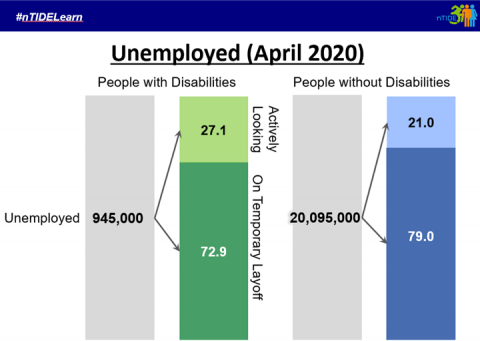
The coronavirus outbreak is affecting hundreds of thousands of people and having a growing impact on the economy and employment. During this special additional nTIDE Lunch & Learn, our team of experts will share their latest perspectives, based on data from a population survey released mid-month, on the coronavirus pandemic and its implications on employment, emerging bills and policies, and resources for the days ahead.
nTIDE May 2020 Special Report: Workers with disabilities in the COVID economy
Kessler Foundation and University of New Hampshire nTIDE Special Report—featuring economist Andrew Houtenville, PhD, policy strategist Denise Rozell, and disability employment expert John O’Neill, PhD
Durham, NH – May 20, 2020: The COVID Recession is unlike any prior recession for all workers, with and without disabilities, according to today’s National Trends in Disability Employment (nTIDE) Special Report, issued by Kessler Foundation and the University of New Hampshire’s Institute on Disability (UNHIOD).
As reported in the April nTIDE Jobs Report, the COVID Recession hit workers with disabilities harder. From March to April, the number of employed working-age people with disabilities decreased by 950,000 (from 4,772,000 to 3,827,000), a 20 percent reduction, while the number of employed working-age people without disabilities decreased by 14 percent (from 140,135,000 to 120,804,000). [Note: these estimates compare the reference weeks of the underlying survey March 8-14 and April 12-18.]

The COVID Recession is unlike any other recession in at least one distinct way. The vast majority of the unemployed are “on temporary layoff” (a.k.a., furloughed), meaning they may potentially be “recalled.” Of the 945,000 unemployed working-age people with disabilities in April, 689,000 (72.9 percent) were on temporary layoff, compared to 78.1 percent of unemployed working-age people without disabilities. Historically, this statistic (when looking at all people ages 16 and older) has never exceeded 28.1 percent, a level reached in February 1975 during the 1973-1975 Oil Crisis/Stagflation Recession (Bureau of Labor Statistics, time series LNU03023654).
“From the perspective of the trends in disability employment that nTIDE has been tracking, the percentage for temporary layoff is a bit of a relief,” according to Andrew Houtenville, PhD, research director of the University of New Hampshire’s Institute on Disability. “This indicates that many people with disabilities may be able to return to work as the COVID pandemic diminishes and the economy opens up. However, as the months pass, more and more employers may shut down permanently,” cautioned Dr. Houtenville, “converting some temporary layoffs to job losses. This is definitely a statistic to follow going forward.”
The COVID-19 pandemic appears to influence absence from work for people with and without disabilities. In April 2020, 13.4 percent of employed working-age people with disabilities and 8.1 percent of employed working-age people without disabilities were absent in the reference week, April 12-18, 2020, compared with 5.5 percent and 2.3 percent, respectively, in April 7-13, 2019. These statistics have never been higher. [The earliest available estimate is from September 2008.] These absences may be due to a worker’s own illness/injury, child-care problems, family illness, and other reasons. When looking at workers’ illness/injury only, 4.8 percent of employed working-age people with disabilities and 1.3 percent of employed working-age people without disabilities were absent in the reference week, April 12-18, 2020.
“As for all workers, COVID-19 may affect the ability of workers with disabilities to go to work,” noted John O’Neill, PhD, director of employment and disability research at Kessler Foundation. “Many people with disabilities rely on public transportation systems, which may now offer limited service and represent an exposure risk. Workers with disabilities who use personal care assistance (PCA) services may have difficulty coordinating assistance due to lack of caregiver availability, and the lack of personal protective equipment (PPE).”
Also reported in the April nTIDE Jobs Report, the labor force participation rate of working-age people with disabilities decreased from 33.3 percent in April 2019 to 32.7 percent in April 2020 (down 1.8 percent or 0.6 percentage points), compared to 76.8 percent in April 2019 to 73.6 percent in April 2020 (down 4.2 percent or 3.2 percentage points) for working-age people without disabilities. The labor force participation rate is the percentage of the population that is working, on temporary layoff, or actively looking for work.
“While the labor force participation rate decreased substantially, it is good to see that many non-employed workers are staying engaged in the labor force, either actively looking for work or on temporary layoff. This is another statistic to follow going forward,” emphasized Dr. Houtenville. “The percentage of people who are actively looking is higher among people with disabilities,” he noted, “a sign that they are continuing to strive to work.”
Beyond the Numbers: Challenges and Opportunities
Both people with and without disabilities are being negatively impacted by the COVID-19 pandemic in terms of both absence from work and layoffs. At this point in time, the effects seem to be proportionately similar for both groups, with greater numbers of people being absent from work and laid off than during the Great Recession of 2008-2009.
The implications are profound for organizations that provide direct services for people with disabilities, such as state vocational rehabilitation agencies, community-based employment programs, and independent living services. These service providers are adapting to the situation, assisting clients with acute needs for technology, personal protective equipment (PPE), and food and shelter, as well as escalating needs for employment services. For example, staff are advocating for clients who have been laid off and need help applying unemployment and other benefits, and seeking guidance for the safe return of high-risk individuals to work.
Technology is now a priority, as workers adapt to working remotely, interviews and training become virtual, and more services must be accessed online, including telehealth and telerehabilitation. This created ongoing challenges for both service providers and their clients, many with immediate needs for computer hardware and software and home internet access. Providing the means for remote access to the workplace may increase the likelihood of returning to work for some employees with disabilities, while also allowing access to health care, and offsetting the negative effects of social isolation. Technology may also enable service organizations to transform their delivery models, and continue operations, providing community-based services that are needed more than ever.
As more jobs shift to work at home options, some people with disabilities are gaining advantage in the workplace. Placement firms like Boston-based National Telecommunicating Institute, which has connected jobseekers with disabilities with temporary work-at-home positions for many years, are seeing a major increase in demand for workers prepared to work from home. As remote work and flexible work arrangements quickly become standard options for all workers, these will no longer be viewed as accommodations for workers with disabilities. Providers of customized employment programs are seeking opportunities to bring workers back into new work environments. The drive toward accessible and affordable high-speed internet and secure and reliable tools for collaboration will bring benefits to many workers at all kinds of businesses, and increase access to higher education for individuals with disabilities.
Adequate supplies of personal protective equipment is another priority for workers with disabilities, especially those who rely on caregivers. Providing PPE for working people who require assistance with personal care will minimize this barrier to receiving the care they need to continue working, and minimize their risk for infection and absence due to illness.
Even in the best of times, many people with disabilities, working or not, experience food insecurity. With the public health crisis requiring sheltering at home, food insecurity is exacerbated. Those laid off often need to apply or reregister for SNAP benefits, and are relying on service providers and advocates to work through the bureaucracy. Fearful of leaving home or unable to leave, people with disabilities often rely on food banks that lack delivery services. There is a need for expanded flexibility of nutritional support programs, such as SNAP, including options for food delivery, and for standardizing benefits across the country. Legislative efforts that include these issues, such as a bill recently passed by the House, need the support of the disability community.
As the COVID-19 pandemic evolves across the U.S., the changes to the employment landscape will continue to bring challenges and opportunities. The nTIDE team will continue to host an open dialogue aimed at ensuring the health and safety of workers with disabilities, and finding new ways to maximize their inclusion in the workplaces of the post-pandemic era.
nTIDE Lunch & Learn
View the special recorded episode of the nTIDE Lunch & Learn series, which was broadcast May 15th. This episode, hosted via Zoom Webinar, offered attendees Q&A on these findings. Dr. O’Neill, Dr. Houtenville, and Denise Rozell, described these findings and their implications for people with disabilities and the public and private agencies that provide employment services. The recording may be found at ResearchonDisability.org/nTIDE.
